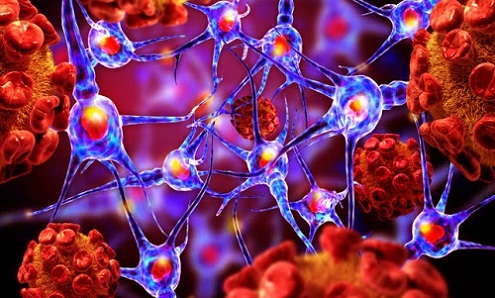Nikhil Prasad Fact checked by:Thailand Medical News Team Feb 06, 2025 2 months, 1 week, 7 hours, 20 minutes ago
Medical News: Ancient Viruses in Our DNA Linked to Brain Disorders
Scientists from the University of Zurich, ETH Zurich, and the University of Bern have discovered new evidence linking ancient viral remnants in human DNA to various brain disorders, including schizophrenia, autism, and Alzheimer’s disease. These viruses, known as endogenous retroviruses (ERVs), make up about 8% of the human genome and have remained largely inactive for thousands of years. However, recent studies suggest that their abnormal activation could contribute to neurological and psychiatric conditions.
 Endogenous Retroviruses in Neurodevelopmental Psychotic and Cognitive Disorders
How Dormant Viruses Might Affect the Brain
Endogenous Retroviruses in Neurodevelopmental Psychotic and Cognitive Disorders
How Dormant Viruses Might Affect the Brain
ERVs are genetic fragments left behind by viral infections in our ancestors. Normally, these elements remain inactive due to the body’s natural defense mechanisms. However, this
Medical News report highlights that certain conditions, such as infections, stress, or inflammation, may reactivate these dormant viruses, potentially leading to harmful effects on brain function.
Researchers have found that different ERV families are linked to specific disorders. For instance, abnormal activation of HERV-H and HERV-K is commonly found in individuals with autism spectrum disorder (ASD) and attention deficit hyperactivity disorder (ADHD). Meanwhile, elevated HERV-W activity has been strongly associated with schizophrenia and bipolar disorder. Studies also indicate that ERVs could play a role in neurodegenerative diseases like Alzheimer’s disease (AD) and frontotemporal dementia (FTD), possibly accelerating brain deterioration.
The Connection Between ERVs and Mental Health Disorders
In individuals with schizophrenia and bipolar disorder, studies have shown increased levels of HERV-W gene expression in blood samples, cerebrospinal fluid, and even brain tissues. One study found that 29% of people with newly diagnosed schizophrenia had detectable levels of HERV-W in their cerebrospinal fluid.
Scientists also observed that patients with high HERV-W activity displayed more severe symptoms and elevated levels of inflammation in their bodies.
Animal studies provide further support for this theory. Researchers have induced schizophrenia-like symptoms in mice by triggering ERV activity, leading to behavioral and cognitive abnormalities similar to those seen in human patients. This suggests that ERV activation might play a direct role in the development of psychiatric disorders.
ERVs and Neurodevelopmental Disorders
In children with autism, higher levels of HERV-H expression have been linked to severe communication and motor function impairments. In some cases, mothers of children with autism also showed abnormal ERV activity, indicating that these viral elements may have a genetic or prenatal influence on neurodevelopmental conditions. Similar trends were observed in children with ADHD, where increased HERV-H activity correlated with hyperactivity and
attention deficits. Remarkably, treatment with ADHD medication was found to reduce HERV-H activity, suggesting a potential connection between ERVs and the disorder's symptoms.
ERVs and Cognitive Decline
Beyond psychiatric and neurodevelopmental disorders, ERVs have also been implicated in neurodegenerative diseases such as Alzheimer’s. Researchers found that abnormal ERV activation correlates with the presence of neurofibrillary tangles, a key marker of Alzheimer’s disease. Brain samples from Alzheimer’s patients showed increased HERV-Fc1 transcripts, which were linked to cognitive decline in the year before death.
Similarly, in frontotemporal dementia (FTD), scientists detected heightened HERV-K activity in affected brain regions. This abnormal activation was associated with behavioral changes, memory loss, and impaired executive function. Notably, HERV-K proteins were found to colocalize with TDP-43, a protein known to contribute to FTD pathology.
Can We Target ERVs for Treatment?
Given the strong association between ERV activity and brain disorders, researchers are now exploring ways to block their activation as a potential treatment strategy. One promising approach involves neutralizing antibodies designed to target HERV-W proteins. A clinical trial for multiple sclerosis (MS), a disease also linked to ERV activity, found that patients treated with a HERV-W blocking antibody experienced reduced brain inflammation and slower disease progression.
Further studies are needed to determine whether similar treatments could benefit patients with schizophrenia, bipolar disorder, or Alzheimer’s disease. Researchers are also investigating how external factors such as viral infections, stress, and environmental toxins may contribute to ERV activation and whether modifying these triggers could help prevent or reduce symptoms of neurological disorders.
The Path Forward
While much remains unknown about the exact role of ERVs in neurodevelopmental, psychiatric, and neurodegenerative conditions, the emerging evidence is compelling. Scientists continue to explore the mechanisms through which these ancient viral remnants influence brain health. By identifying how and when ERVs become active, researchers hope to develop new interventions to reduce their harmful effects and potentially improve the lives of millions affected by these disorders.
The study findings were published in the peer-reviewed journal: Microbes and Infection.
https://www.sciencedirect.com/science/article/pii/S1286457925000115
For the latest on Endogenous Retroviruses, keep on logging to Thailand
Medical News.
Read Also:
https://www.thailandmedical.news/news/activation-of-endogenous-retroviruses-and-its-role-in-covid-19-immunopathology
https://www.thailandmedical.news/news/breaking-sars-cov-2-upregulates-endogenous-retroviruses-that-play-a-role-in-covid-19-pathogenesis
https://www.thailandmedical.news/news/covid-19-news-sars-cov-2-reactivation-of-human-endogenous-retroviruses-contributes-to-kawasaki-disease,-mis-c-and-even-covid-19-severity
https://www.thailandmedical.news/news/covid-19-news-researchers-discover-that-sars-cov-2-infection-activates-endogenous-retroviruses-of-the-ltr69-subfamily
https://www.thailandmedical.news/news/breaking-covid-19-news-study-discovers-that-sars-cov-2-modulates-human-endogenous-retrovirus-herv-transcriptome-during-infection
https://www.thailandmedical.news/news/breaking-sars-cov-2-infection-induces-human-endogenous-retrovirus-type-w-envelope-protein-expression-in-blood-lymphocytes-and-tissues
